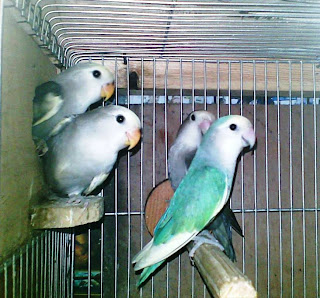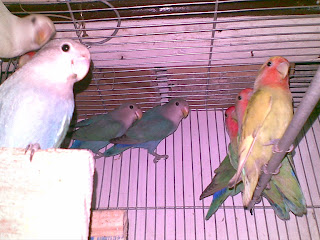There are 9 species of african lovebirds which all came from the native wild in africa except for Madagascar Lovebird (Agapornis cana) which came from the wild of Madagascar.They belong to the parrot family and they are the smallest parrot.
Among the 9 specie there only 4 common bird in captivity the Agapornis roseicollis which we call the peach faced lovebirds as the popular then the Agapornis fischeri fischer lovebirds, the Agapornis personata Masked Lovebird and the Agapornis nigrigenis Black-checked Lovebird which becoming popular also.
There are also two types of lovebirds the eye ring type which includes Agapornis fischeri fischer lovebirds, the Agapornis personata Masked Lovebird and the Agapornis nigrigenis Black-checked Lovebird and the non eye ring type include the Agapornis roseicollis the peach faced lovebirds.
Peach-faced Lovebird Agapornis roseicollis These are the most widely kept of the lovebirds and are breed in large numbers not surprisingly, several mutations have become established including Pastel blue, yellow, Lutino and Pied. The normal cock and hen are similar in color, except that the hen may be a bit paler. The body is olive green, lighter on the belly. The head, throat and breasts are a bright peach pink. The flight feathers are black and there are red, blue, and black markings in the green tail feathers.
Fischer's Lovebird Agapornis fischeri
This species comes from northwestern Tanzania, south of Lake Victoria. The sexes are similar in appearance, basically green, with light green on the underparts. The forehead, cheeks and throat are bright orange, merging into yellowish orange on the breast and nape of neck. The rump is blue and there are blue, orange, and black markings on the tail. The beak is red, the feet and legs gray. The irises are brown. This species is fairly common, breeds readily, and a number of color mutations have been developed.
Masked Lovebird Agapornis personata
Found in Tanzania, but is in the northeast, this species does not overlap the range of the preceding species. The sexes are similar in appearance. The head is a dark sooty brown. The wings are a dark green, the underside is lighter. The breast and the nape of the neck are yellowish and the flight feathers are black. The rump is a grayish blue. The beak is red, the legs and feet gray. This species is fairly often seen in captivity
Black-checked Lovebird Agapornis nigrigenis Found only in a small area of Zaire, this species was extremely popular with aviculturists during the 1920's when large numbers were captured. The sexes are similar in color, the back is dark green, the underparts greenish yellow. The forehead and crown are reddish brown, merging into black on the checks. There is a band of orange on the upper breast and the nape. The beak is red, the feet and legs grayish and the irises are brown. Not common in captivity but breeds readily.
Madagascar Lovebird Agapornis cana
Sometimes called the gray-headed lovebird, This species is found on the island of Madagascar( Malagasy Republic). It has also been introduced to some other Indian Ocean islands. The cock has a dark green back and wings, a light belly, and the head and chest are whitish gray. The beak, legs, and feet are light gray and there are black markings on the tail. The iris is brown. The female is easily distinguished from the cock as she lacks the gray patch on her forehead. These lovebirds are rarely seen in captivity as there are export restrictions from their native country.
Red-Faced Lovebird Agapornis pullaria
This species is found in equatorial Africa, ranging from Sierra Leone to Lake Albert in Uganda. In the west of it's range it extends down as far as northern Angola. The cock has a bright green body, verging into yellowish on the underparts. The forehead and face are bright orange-red and there are black flight feathers. The rump is blue and there are small amounts of red, yellow and black in the tail feathers. The beak is red , the feet and legs are gray and the eyes are brown. The hen is similar in color but paler.
Abyssinian Lovebird Agapornis taranta
Another name for this species is the Black-winged Lovebird. It is found in central and eastern Ethiopia and southern Eritrea, where it inhabits quite high altitudes. The cock is mainly green, with a bright red forehead, which extends into a narrow ring around the eyes. The flight feathers are sooty black and there is a black bar on the tail. The beak is red, the legs and feet are gray. The hen is green all over, darker on the back lacking the red and black markings of the cock. They are occasionally available on the market, but are one of the most difficult species to breed.
Nyasa Lovebird Agapornis lilianae
This, and the remaining species all possess a ring of feather free, white skin around each eye, giving rise to the term the white eye-ringed group. The Nyasa Lovebird is found in parts of Zambia Malawai and Rhodesia. The sexes are similar in appearance. The back and wings are dark green, the underside lighter with a yellowish tinge. The head, neck and breast are a bright orange-red more vivid on the head, merging into yellowish on the breast. The beak is red, the feet and legs gray and the irises brown. Hens are said to be darker in color than the cocks.
Swindern's Lovebird Agapornis swinderniana One of the rarest lovebird, This species is rarely seen in captivity. There are three subspecies known which occur in Liberia, the Camaroons and Zaire. The sexes are similarly marked; mainly green with a characteristic half collar at the nape. The chest is orange-yellow, merging into yellow on the bell. The rump and tail have blue and red markings. The beak, feet and legs are gray, the iris yellow































 Black Checked Green african lovebird
Black Checked Green african lovebird